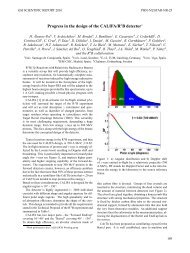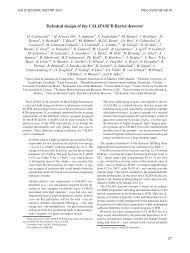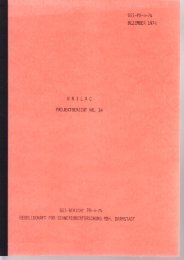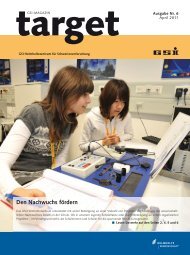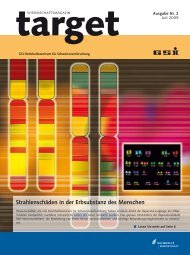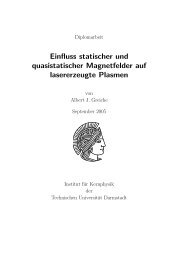download block - GSI Helmholtzzentrum für Schwerionenforschung
download block - GSI Helmholtzzentrum für Schwerionenforschung
download block - GSI Helmholtzzentrum für Schwerionenforschung
Create successful ePaper yourself
Turn your PDF publications into a flip-book with our unique Google optimized e-Paper software.
<strong>GSI</strong>-UPGRADE-ACC-02 <strong>GSI</strong> SCIENTIFIC REPORT 2009<br />
146<br />
<strong>GSI</strong>Template2007<br />
HSI-Frontend Upgrade<br />
W. Barth, L. Dahl, M.-S. Kaiser, A. Kolomiets*, S. Mickat, S. Minaev*, W. Vinzenz, H. Vormann,<br />
S. Yaramyshev<br />
<strong>GSI</strong>, Darmstadt, Germany; *ITEP, Moscow, Russia.<br />
Overview HSI-Frontend Upgrades<br />
To fulfil the requirements of FAIR (15 emA of U 28+<br />
with min. 70 µs pulse length to be injected into SIS18),<br />
the UNILAC has to be upgraded in several sections: the<br />
LEBT [1], the HSI-RFQ [2], the Alvarez main accelerator<br />
[3], and high current beam diagnostics [4].<br />
Corresponding to the requirements of FAIR, the High<br />
Current Injector HSI has to deliver 18 mA U 4+ at HSI<br />
output. This cannot be achieved with the RFQ and the<br />
LEBT as existing up to 2008. Therefore a three-step upgrade<br />
of this HSI-Frontend is scheduled: The RFQ-<br />
Upgrade has been realized in 2009, the LEBT-upgrade I<br />
(quadrupole quartet and switching magnet) is foreseen for<br />
2010, followed by LEBT-upgrade II with an additional<br />
linear source branch (Compact LEBT), as a part of the<br />
FAIR-UNILAC upgrade.<br />
Figure 1: HSI-Frontend upgrade, including new ion<br />
source terminal and Compact LEBT.<br />
HSI-RFQ Upgrade<br />
In a prior upgrade of the HSI-RFQ (2004), a modified<br />
input radial matching section (IRM) was installed, resulting<br />
in significantly increased high current transmission,<br />
confirmed by simulations [5].<br />
In 2009, the HSI-RFQ has been upgraded again, now<br />
with a completely new beam dynamics design of the new<br />
electrodes [2]. With an enlarged aperture and higher voltage<br />
(155 kV instead of 125 kV at Uranium level, but max.<br />
surface peak field held lower than the old design), the<br />
acceptance is increased. With an improved IRM design<br />
the emittance in the radial matching section is keeping<br />
small.<br />
A constant average aperture, transverse electrode vane<br />
shape and carrier ring dimension along the whole RFQ<br />
was chosen from simulations to meet the resonance frequency<br />
and a flat voltage distribution. After machining<br />
and reassembly of the RFQ, first measurements during the<br />
RF tuning period confirmed the predicted properties. As<br />
expected from the comparison of simulations and measurements<br />
of existing resonator sections, only six fixed<br />
plungers were needed.<br />
Besides mechanical modifications, the power supply<br />
for the RF transmitter has been equipped with bigger capacitors,<br />
to provide for the higher total RF power and for<br />
acceptable reliability. RF conditioning took only four days<br />
to reach the argon level (104 kV, 330 kW), and three more<br />
weeks to reach uranium level (155 kV, 1.2 MW). Conditioning<br />
for uranium level was proceeded for additional six<br />
weeks, until the necessary RF-power decreased<br />
(1.0 MW).<br />
HSI-RFQ New Design Existing Design<br />
Electrode voltage / kV 155 125<br />
Average aperture radius / cm 0.6 0.5245 – 0.7745<br />
Electrode width / cm 0.846 0.9 – 1.08<br />
Maximum field / kV/cm 312.0 318.5<br />
Modulation 1.012 – 1.93 1.00 – 2.09<br />
Synch. Phase, degrees -90 0 - -28 0 -90 0 - -34 0<br />
Minimum aperture radius, cm 0.410 0.381<br />
Number of cells with modulation 394 343<br />
Length of electrodes, cm 921.74 921.74<br />
Table 1: Design parameters of the HSI-RFQ.<br />
Figure 2: New RFQ electrodes, with new IRM.<br />
Electrodes and carrier rings<br />
July 2008<br />
fabrication, assembly<br />
- April 2009<br />
RF tuning (prelim. assembled) May 2009<br />
Re-assembly in beamline June 2009<br />
Beam-commissioning with argon July 2009<br />
Beam-commissioning with uranium,<br />
routine heavy ion high current operation<br />
since September 2009<br />
Table 2: RFQ upgrade schedule.<br />
Beam-commissioning started in July 2009 with Ar 1+ .<br />
For this an emittance measurement device was installed<br />
behind the RFQ. Transmission measurements showed a<br />
gain of 50 % compared to the previous RFQ-design: After





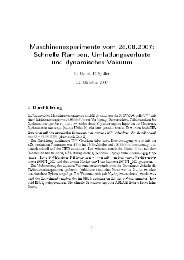
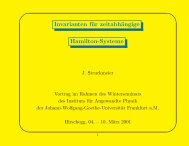
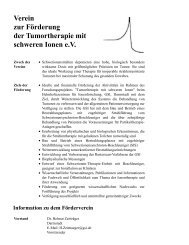
![GS I -P-]-17 - GSI Helmholtzzentrum für Schwerionenforschung](https://img.yumpu.com/20698964/1/184x260/gs-i-p-17-gsi-helmholtzzentrum-fur-schwerionenforschung.jpg?quality=85)

